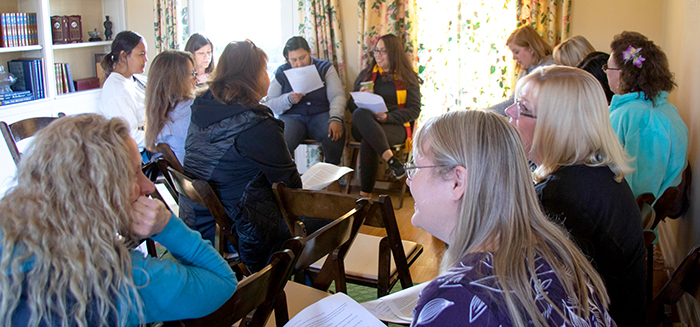Clairbourn Staff Development: Neurodiversity and Student Support
Serving the learning differences among students is a hot topic in education today. In order to ensure that Clairbourn School’s teachers continue to deliver the highest standard of student care, a staff development session was held on Monday, January 6, to deepen awareness of student learning differences and to expand teachers’ collection of resources and strategies.
Speaker Tami Millard, an educational specialist at The Center for Connection in Altadena, California, addressed Clairbourn teachers at the staff meeting with a follow-up talk on “Student Support.” She spoke earlier in September on the topic of “Neurodiversity,” which means we are all uniquely wired with our own set of strengths and challenges. As part of her talk, she encouraged teachers to “chase the why” behind classroom behavior (avoiding good or bad evaluation language) and to instead discover what unmet need the student is struggling to communicate.
Speaker Tami Millard, an educational specialist at The Center for Connection in Altadena, California, addressed Clairbourn teachers at the staff meeting with a follow-up talk on “Student Support.” She spoke earlier in September on the topic of “Neurodiversity,” which means we are all uniquely wired with our own set of strengths and challenges. As part of her talk, she encouraged teachers to “chase the why” behind classroom behavior (avoiding good or bad evaluation language) and to instead discover what unmet need the student is struggling to communicate.
Her follow-up talk on Monday was designed to facilitate teacher implementation of these ideas of both Neurodiversity and supporting student learning differences. She brought with her several case studies designed to generate discussion. Teachers were encouraged to clarify for themselves, “What does student support look like…What is integrated student care?” The teachers, specialists, and administrators were then divided into grade-level groups where they discussed the case studies. This was followed by time for sharing key ideas with the larger group.

Tami Millard summarized the value of this integrated approach as an efficient and effective way to identify what is really happening with a student, and it can help determine priorities and the next steps to take. Physical education, music, art, library, and computer specialists have unique insights that can combine with those of teachers and administrators. When there is a system for multiple views to come together and be shared, a more complete picture of student needs emerges than would otherwise be possible to achieve.

The discussion can start with the following five key questions:
Tami Millard wrapped-up her talk by sharing her favorite list of powerful resources covering effective learning and reading strategies and assessment, accommodations for math learners, English-learner math assistance, and instructional practices for English language learners.
Back

Preschool teachers and assistants, lower school teachers, subject-area specialists, and administrators discussed younger-child case studies to strengthen their understanding and implementation of integrated student care.
Tami Millard summarized the value of this integrated approach as an efficient and effective way to identify what is really happening with a student, and it can help determine priorities and the next steps to take. Physical education, music, art, library, and computer specialists have unique insights that can combine with those of teachers and administrators. When there is a system for multiple views to come together and be shared, a more complete picture of student needs emerges than would otherwise be possible to achieve.

Middle school teachers, subject-area specialists, and administrators discussed older-student case studies and developed key ideas for implementing student care.
The discussion can start with the following five key questions:
- What are the observable student strengths and challenges?
- What classroom challenges feel like a priority to address?
- What whole-class or individual strategies can be sustainably integrated?
- What aspects of a child’s situation feel unknown?
- Who or what resources at school can be accessed?

Tami Millard provided a well-researched guide of resources for teachers to use when applying integrated student support.
Tami Millard wrapped-up her talk by sharing her favorite list of powerful resources covering effective learning and reading strategies and assessment, accommodations for math learners, English-learner math assistance, and instructional practices for English language learners.
Families who choose Clairbourn know, as demonstrated by this recent staff meeting, that our school is serious about serving the deeper needs of each student. With its commitment to small class sizes and individualized attention, students at Clairbourn are receiving a valuable type of support and encouragement needed to build confidence, a love of learning, character and social skills, and especially to advance academically.
Clairbourn thanks Tami Millard for sharing her expertise with our teachers at staff development meetings.
Clairbourn thanks Tami Millard for sharing her expertise with our teachers at staff development meetings.
Private School Education for Preschool, Kindergarten, Elementary School, & Middle School Grades - Serving Families in the Pasadena Area and Surrounding Cities
Clairbourn is a 501(c)3 charitable organization. (K-12 Private Schools), Child Care Facility license # 191500903












